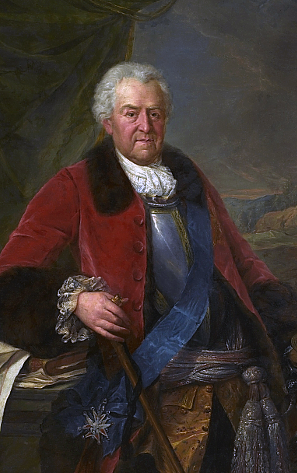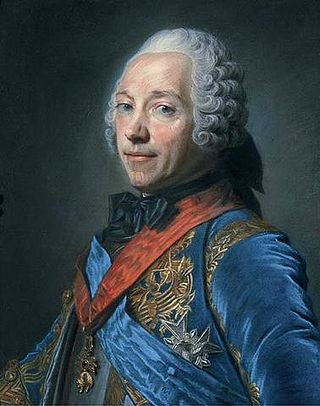
The War of the Polish Succession was a major European conflict sparked by a civil war in the Polish–Lithuanian Commonwealth over the succession to Augustus II the Strong, which the other European powers widened in pursuit of their own national interests. France and Spain, the two Bourbon powers, tested the power of the Austrian Habsburgs in Western Europe, as did the Kingdom of Prussia, whilst Saxony and Russia mobilized to support the eventual victor. The fighting in Poland–Lithuania resulted in the accession of Augustus III, who in addition to Russia and Saxony, was politically supported by the Habsburgs.

The War of the Austrian Succession was a European conflict fought between 1740 and 1748, primarily in Central Europe, the Austrian Netherlands, Italy, the Atlantic Ocean and Mediterranean Sea. Related conflicts include King George's War in North America, the War of Jenkins' Ear, the First Carnatic War, and the First and Second Silesian Wars.

Stanisław I Leszczyński, also Anglicized and Latinized as Stanislaus I, was twice King of Poland and Grand Duke of Lithuania, and at various times Prince of Deux-Ponts, Duke of Bar and Duke of Lorraine.

James FitzJames, 1st Duke of Berwick was a French Royal Army officer and nobleman who was the illegitimate son of James II of England by Arabella Churchill, the sister of John Churchill, 1st Duke of Marlborough. Berwick was a successful general in the service of Louis XIV.

Augustus III was King of Poland and Grand Duke of Lithuania from 1733 until 1763, as well as Elector of Saxony in the Holy Roman Empire where he was known as Frederick Augustus II.

Claude Louis Hector de Villars, Prince of Martigues, Marquis then (1st) Duke of Villars, Viscount of Melun was a French military commander and an illustrious general of Louis XIV of France. He was one of only six Marshals to have been promoted Marshal General of France.

Stanisław Poniatowski was a Polish military commander, diplomat, and noble. Throughout his career, Poniatowski served in various military offices, and was a general in both the Swedish and Polish–Lithuanian militaries. He also held numerous civil positions, including those of podstoli of Lithuania and Grand Treasurer of the Lithuanian army in 1722, voivode of the Masovian Voivodeship in 1731, regimentarz of the Crown Army in 1728, and castellan of Kraków in 1752. Throughout his lifetime, he served in many starost positions.

Charles Louis Auguste Fouquet, duc de Belle-Isle was a French general and statesman.

The Battle of Bitonto was a Spanish victory over Austrian forces near Bitonto in the Kingdom of Naples in the War of Polish Succession. The battle ended organized Austrian resistance outside a small number of fortresses in the kingdom.

The 1st Lithuanian–Belarusian Division was a volunteer unit of the Polish Army formed around December 1918 and January 1919 during the Polish–Soviet War. It was created out of several dozen smaller units of self-defence forces composed of local volunteers in what is now Lithuania and Belarus, amidst a growing series of territorial disputes between the Second Polish Republic, the Russian SFSR, and several other local provisional governments. The Division took part in several key battles of the war. According to Paulius Pacevičius around 15-18% of the division were ethnic Lithuanians.

Colorno is a comune (municipality) in the Province of Parma in the Italian region Emilia-Romagna, located about 90 kilometres (56 mi) northwest of Bologna and about 15 kilometres (9 mi) north of Parma.

Joseph Maria Frederick Wilhelm of Saxe-Hildburghausen, Duke in Saxony, was a German officer, Generalfeldmarschall of the Imperial Army and Reichsgeneralfeldmarschall (Reichsgeneralfeldzeugmeister) of the Army of the Holy Roman Empire. He is best known for commanding the Franco-Roman-German at the Battle of Rossbach, losing to the Prussian Army.
The Battle of San Pietro, also known as the Battle of Crocetta or the Battle of Parma was fought on 29 June 1734 between troops of France and Sardinia on one side, and Habsburg Austrian troops on the other, as part of the War of Polish Succession, between the village of La Crocetta and the city of Parma, then in the Duchy of Parma. Austrian troops assaulted an entrenched Franco-Sardinian position, and were ultimately repulsed, due in part to the death of their commander, Florimund Mercy, and the wounding of his second in command, Frederick of Württemberg. Both sides suffered significant casualties in the battle, which lasted for most of the day.

The Battle of Guastalla or Battle of Luzzara was fought on 19 September 1734 between Franco-Sardinian and Austrian (Habsburg) troops as part of the War of the Polish Succession.

Polish–French relations are relations between the nations of Poland and France, which date back several centuries.

The Grunwald Swords are a pair of simple bare swords sent as a mocking "gift" by Ulrich von Jungingen, the Grand Master of the Order of Teutonic Knights, to King Władysław II Jagiełło of Poland and Grand Duke Vytautas of Lithuania. The swords were sent on 15 July 1410, just before the Battle of Grunwald (Tannenberg), as a symbolic invitation to engage Jungingen's forces in battle. After the Polish–Lithuanian victory, both swords were taken as a war trophy by King Władysław II to Kraków, Poland's capital at the time, and placed in the treasury of the Royal Wawel Castle.
The siege of Capua was the last major military action of the War of the Polish Succession in the Kingdom of Naples. Austrian forces of the Habsburg monarchy, under the command of the Austrian Marshal Otto Ferdinand von Abensberg und Traun, withstood for seven months a blockade begun in April 1734 by Spanish and French forces under Count Marsillac. General Traun surrendered the fortress of Capua in November 1734 with full honors of war, primarily because of exhausted provisions and ammunition, but also because it was clear no relief was coming to the isolated garrison.
Lord Charles Hay was a soldier of the British Army who saw service in the Anglo-Spanish War, the Wars of the Polish and Austrian Successions, and the Seven Years' War. He combined this with a political career, sitting for a time as a member of parliament.
Auguste de Keralio was a French military man. He was made a knight of the Order of Saint Louis and gentleman of the chamber to the Prince of Parma on 2 October 1760. He was also known as the marquis of Keralio.













